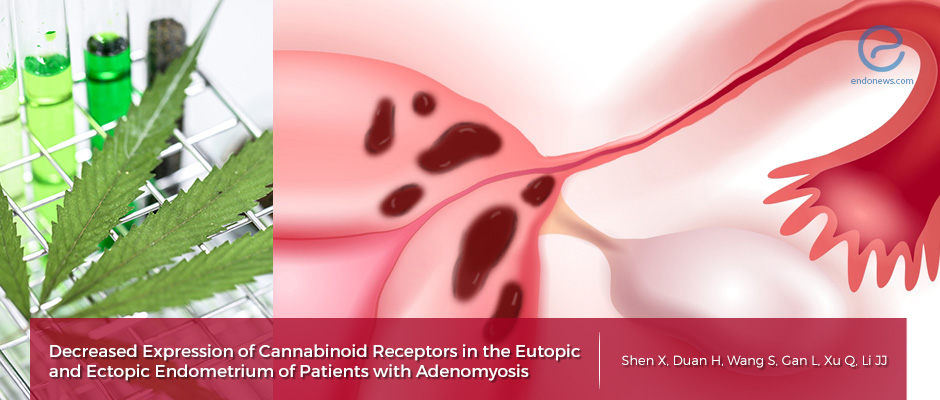New findings in adenomyosis (endometriosis interna) patients with potential theraupetic research implications
May 21, 2019
Cannabinoid receptor levels are low in eutopic and ectopic endometria of adenomyosis patients
Key Points
Highlight:
- Adenomyosis, also called "endometriosis interna", is a common estrogen-dependent uterine disorder distinguished by the nonmalignant invasion of the bioactive endometrium into the uterine muscle layer. Little is known about its etiology and its pathogenesis.
- In this study, the two classical cannabinoid receptors, CB1 and CB2 were examined and found to be reduced in the eutopic and ectopic endometrium from adenomyosis patients, regardless of the menstrual phase.
Background:
- Medical therapy is important in the management of adenomyosis, however, the rationale for it rests on the pathogenetic mechanisms of adenomyosis.
- Endocannabinoids are endogenously produced bioactive molecules. Their effects are mediated by two classical receptors, the cannabinoid receptor 1 (CB1) and cannabinoid receptor 2 (CB2).
- Recent research has revealed certain interactions between endocannabinoids and endometriosis besides affecting angiogenesis in several tumors and fibrogenesis.
Key points:
- Forty-five women pathologically diagnosed with adenomyosis and thirty-four women with no evidence of adenomyosis were recruited in this study.
- The two classical cannabinoid receptors CB1 and CB2 were both reduced in the eutopic and ectopic endometrium from adenomyosis patients, regardless of the menstrual phase, by immunohistochemistry and qRT-PCR techniques.
Conclusions:
- This study with a fairly large sample size of patients showed that in adenomyosis, CB1 and CB2 protein and mRNA levels were considerably lower in the ectopic and eutopic endometrium in both phases of the cycle.
- Although CB1 and CB2 protein and mRNA levels were increased during the secretory phase in normal endometrium, CB1 lost its cyclic variation in the eutopic and ectopic endometrium from adenomyosis patients.
- The lack of cyclic variation in CB1 in adenomyosis suggests that it plays an important role in the pathogenesis of adenomyosis.
Lay Summary
Xue Shen and associates from Beijing, China have published their observations related to cannabinoid receptors, i.e., CB1 and CB2, in patients with adenomyosis, recently in the journal "Biomed Research International".
Adenomyosis is an estrogen-dependent uterine disorder where a nonmalignant invasion of the bioactive endometrium into the myometrium occurs, and little is known about its etiology and its pathogenesis. Since uterus means a lot to women, medical therapy is important in the management of adenomyosis, and the rationale for it rests on the pathogenetic mechanisms of adenomyosis, which have much in common with endometriosis.
Endocannabinoids are endogenously produced bioactive molecules. Their effects are mediated by two classical receptors, the cannabinoid receptor 1 (CB1) and cannabinoid receptor 2 (CB2). New research data revealed certain interactions between endocannabinoids and endometriosis besides affecting angiogenesis in several tumors and fibrogenesis.
In this study, 45 women pathologically diagnosed with adenomyosis and 34 women with no evidence of adenomyosis were recruited. Immunohistochemical microscopic visualization and qRT-PCR for m-RNA analysis were applied in assessing CB1 and CB2 in the tissues. CB1 and CB2 protein and mRNA levels were considerably lower in the ectopic and eutopic endometrium in both phases of the cycle of adenomyosis patients. Both CB1 and CB2 protein and mRNA levels were found to be higher during the secretory phase in normal endometrium, while CB1 lost its cyclic variation in the eutopic and ectopic endometrium in patients with adenomyosis.
The lack of CB1 cyclic variation is suggestive for an important role in the pathogenesis of adenomyosis, which appears consistent also with previous observations related to fertility.
The novel findings in this study suggest that CB1 and CB2 participate in the pathogenesis of adenomyosis and further studies will be helpful to determine whether this system could be a novel target to treat adenomyosis. “The next steps would be additional investigations on the association of these two cannabinoid receptors with the clinical characteristics of adenomyosis and potential cytokines, immune cells, and molecular pathways” added the authors.
Research Source: https://www.ncbi.nlm.nih.gov/pubmed/30800671
adenomyosis endocannabioids CB1 CB2 cannabinoid receptors several tumors

